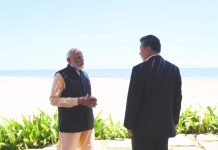The health minister of India JP Nadda said that the polio risk cannot be taken lightly. Over 1.5 lakh oral polio vaccine vials, manufactured by a Ghaziabad based Biomed company, have been found to be contaminated by Type 2 poliovirus. The Health Ministry claims that they ‘will not allow poliomyelitis to make a comeback’.
- Indian Trained Buddhist Monks Banned From Teaching Buddhism in China
- South Africa is as Guilty As Saudi Arabia For Killing Innocents in Yemen
The reality is that when a vaccine virus such as the strain 2 is introduced into a population that has been declared free of the wild strain 2 virus, there are several possible outcomes, some unpredictable. The best response by the global community and the government would be to anticipate and be prepared for the worst.
Firstly, the vaccine virus could mutate into a form that we are not prepared for and this could either be mild or fatal. Secondly, the vaccine virus could spread and cause a vaccine-related poliomyelitis outbreak or epidemic, depending on the vulnerability of the exposed population.
The Oral polio vaccine (OPV) is used in countries like India because experts hope that the immunity will spread in the same way that the virus spreads – the feco-oral route, giving rise to a phenomenon called herd immunity. This simply means that even if 85 – 90% of the population is immunised with the OPV, the other 15% get protected, even if they are not immunised. India benefits from herd immunity because, no matter how hard one tries, there are pockets of the population that get left out of the immunisation process.
India used to initially administer OPV trivalent vaccine with strains 1,2 and 3 as part of the national immunisation schedule as well as the pulse polio campaigns. Vaccine-associated paralytic polio (VAPP) is most likely with the type 2 strain. As long as this strain was being used, even as a vaccine, the chances of eliminating paralytic polio was highly unlikely.
On September 20, 2016, the Global Commission for the Certification of Poliomyelitis Eradication (GCC) concluded that wild poliovirus type 2 (WPV2) has been eradicated worldwide, after reviewing formal documentation by the Member States, global poliovirus laboratory networks and surveillance systems. This led to the removal of the type 2 strain from all vaccines, converting the trivalent to a bivalent vaccine. The reason for the Type 2 strain being removed from the trivalent vaccine is because more than 90% of the vaccine-related outbreaks had been documented to have been caused by the Type 2 strain and 38% of Vaccine Associated Paralytic Polio (VAPP) have been due to this component.
Since 2015, with the removal of all traces of the Type 2 strain, it was expected that populations would have less immunity to this strain and therefore more vulnerable, if the strain was reintroduced. Therefore the switch which removes the Type 2 strain was expected to occur in tandem with the introduction of the Injectable Polio Vaccine (IPV).
Herd immunity does not work with the IPV because this is a killed vaccine and immunity does not spread through the feco-oral route. Only individuals are protected with IPV, not communities, and requires each and every person to be immunised for the entire population to be protected.
Since India does not have a 100% immunisation coverage, the presence of the Type 2 vaccine poliovirus puts those who fall out of the immunisation net at risk of developing poliomyelitis, either with the Type 2 strain or worse, a mutated version of it. If the vaccine virus has been found in stool samples of children, it means that it is already out in the population.
It is not like there are no protocols for what governments should do in the instance of a leak or contamination. According to the Global Polio Eradication Initiative (GPEI), even a single case of wild, vaccine-related poliomyelitis, or a single environmental sample positive for wild or vaccine-related poliovirus with follow up investigation identifying polio-compatible cases or infected persons, should be declared as a polio outbreak. This declaration should be made with 72 hours of notification, especially if the area has vulnerable populations.
Messages on social media and by word of mouth, asking parents not to vaccinate their children, do the rounds much faster and more widely than the government’s response to these kinds of crises. Delayed responses and denial by the government leads to an erosion of faith about immunisation and has long-term consequences. As a knee-jerk reaction, the government then clamps down on those who criticise their immunisation program – the recent arrest of Jacob Vadakancherry by the Kerala government being a case in point.
Vaccination can never be a top-down, dictatorial process as people always find ways to thwart it if they do not believe in it. It also makes vaccination a less participatory process. A government that is honest, quick to respond and well prepared to deal with vaccine-related individual adverse effects and consequences that affect large populations is more likely to make programs more effective.
Arrests may bring temporary reprieve to the government, but the bigger danger is such contaminations taking place at a later date because then the population will be much more susceptible to vaccine-related poliomyelitis.
There are strict guidelines to monitor polio 2 strain from becoming a contaminant. In this instance, an enquiry has to be conducted into how this happened. If this company has been storing the vaccine strain, how did they pass through government regulatory mechanisms?
India would at least qualify as Grade 2, which means there is a moderate risk of continuation and international spread of transmission due to ‘gaps in population immunity, weaknesses in the immunisation system and in-country response infrastructure, major vulnerable population clusters.
If the strain has been detected in the sewage, then it means that it can spread through the feco-oral route. This means that even though two-thirds of the 1.5 lakh vials have been administered and one-third has been withdrawn, the risk of getting vaccine-related poliomyelitis is in a larger population than the two-thirds who have been vaccinated.
The key to successful outbreak response is a high-level government engagement and a declaration of a public health emergency. The Indian government should declare the crisis, notify all global partners, take the necessary precautions and release vaccine recommendations for tourists and visitors to the country, particularly children.
They should also increase the surveillance and, most importantly, keep communities involved with regular updates and guidelines. This would certainly be more useful than denying the problem and pretending that everything is under control.
The article has been taken from TheNewsMinute.com
More News at EurAsian Times
- Is PM Modi Planning to Divide J&K into 3 Parts Before 2019 Elections?
- India Using Israel’s “Palestine Strategy” To Crush Rebellion in Kashmir?
- Saudi Money, US Weapons, Israeli Intelligence Fuelling Arab NATO – Iran
- Indian Army Knows The Exact Location of 12 Terror Launch Pads in Pakistan; But Can They Strike?




